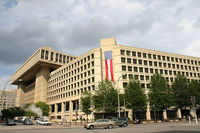FBI building has few friends
The FBI Building creates a “dead zone” in the middle of downtown DC, with oppressive, blank walls on four very large block faces. In its National Capital Framework Plan, NCPC suggests tearing it down and redeveloping the block into newer federal offices above street-level retail.
This is possible because the FBI may move. Their building is insufficiently secure, and the agency is considering other locations around the region. The building is also in terrible shape.
Last weekend, Terrance Lynch of the Downtown Cluster of Congregations endorsed replacing the building in a letter to the Post. “The wide sidewalks around [the site] could be filled with cafe tables, shoppers, and tourist attractions; instead the walkways are frequently blocked off.”
Ironically, while it’s one of DC’s least architecturally notable Brutalist buildings, the FBI building may also be one of the easiest to adapt to better activate the street (maintenance problems aside). According to former Post architecture critic Ben Forgey, the building was originally designed with stores at ground level, until J. Edgar Hoover blocked them. Unlike buildings such as Third Church, the Hilton, HUD, and others, the FBI building comes right out to the street. Instead of huge, windswept plazas, the streetwall features filled-in bays that at least look like they could house shops and cafes.
The Federal Triangle has plenty of old, imposing buildings. The best future for this block would be a new, airier structure with retail along each street and a pedestrian concourse extending D Street to Pennsylvania Avenue.

